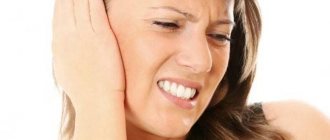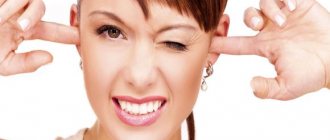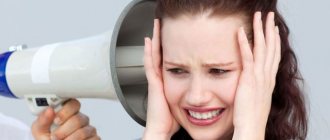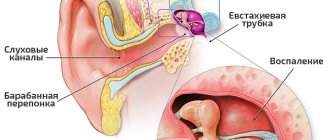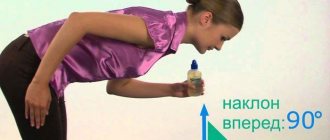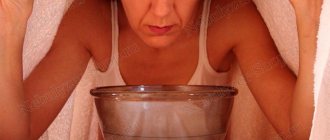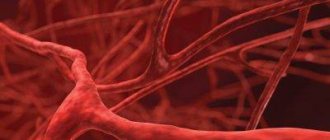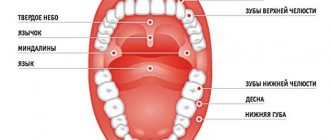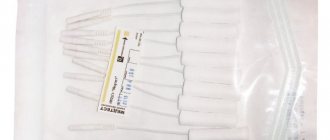Ear blowing
Blowing the eustachian tube involves introducing pressurized air into the hearing organ. The procedure can be performed for therapeutic or diagnostic purposes. It is also carried out in the treatment of complications of otitis media or after tympanoplasty.
However, blowing is not recommended for acute inflammation in the nasopharynx. This is due to the risk of infection entering the tympanic cavity, which will lead to the development of purulent or acute forms of otitis.
The value of the procedure
Ear blowing is required to normalize the functions of the Eustachian tube, reduce symptoms of congestion and reduce discomfort. In case of complex pathologies, the procedure can be performed exclusively under the supervision of an otolaryngologist. However, in most cases you are allowed to do it yourself.
Main indications
Politzer ear blowing has a number of indications, which are diagnosed in consultation with an ENT doctor.
The main function of the eustachian tube is to provide ventilation, drainage and protection of the entire hearing system. Drainage refers to the process of removing exudative fluid. Not only inflammatory diseases, but also mechanical damage and sudden changes in atmospheric pressure can cause disruption of the patency of the pipe . In some cases, complete blockage may occur. Politzer blowing is an excellent method for examining pipes and can also be used to correct some problems.
This procedure is prescribed in the following cases:
- with deterioration in the quality of hearing after otitis media of various etiologies;
- with accumulation of exudative fluid in the tympanic cavity;
- in case of serious complications that arise due to severe forms of nasopharyngeal diseases;
- when the eardrum changes;
- with frequent air travel or frequent immersion under water, which causes pressure changes.
The procedure may also be prescribed to a patient who complains of frequent ear pain or a feeling of stuffiness . If a patient experiences autophony - resonance from the perception of one’s own voice, constant tinnitus, frequent pain - one should immediately consult a doctor. It is especially dangerous if deterioration in health is observed after suffering an infectious or bacterial disease. Most often, ear blowing during otitis is performed in young children, who are more susceptible to attacks by pathogenic organisms and get sick more often due to weakened immunity. The doctor may ask the parents to hold the child, which will have a positive effect on the whole process, because babies behave calmer in the arms of their parents.
Indications
With various diseases of the hearing organ, there is a risk of fluid accumulation in the inner ear. In such a situation, the following manifestations arise:
- feeling of fullness;
- pain syndrome;
- the appearance of extraneous sounds;
- complete or partial hearing impairment;
- problems with coordination of movements;
- dizziness.
Using the blowing procedure, it is possible to cope with a decrease in the patency of the ear canal.
Due to this, this method is actively used in the following situations:
- hearing impairment due to otitis media;
- accumulation of exudate in the ears;
- membrane deformation;
- complications of rhinitis;
- sudden changes in pressure on the membrane.
For what diseases is it performed?
There can be quite a few reasons for discomfort in the ears. Blowing is performed for the following pathologies:
- otitis;
- pathologies of the middle ear;
- allergy;
- infectious diseases;
- pressure fluctuations;
- sulfur plugs.
The listed factors often provoke obstruction of the Eustachian tube. Blowing helps restore it.
Preparing for blowing
This manipulation is performed by introducing air through the patient's nostril. Based on this, it becomes clear that first of all you need to prepare the nasal cavity:
- cleansing the mucous membrane of secretions;
- the use of vasoconstrictor drops (to improve patency).
Before performing this technique on young children and people with mental pathology, you need to weigh the pros and cons, because they need a special approach. These contingents most often require additional training (sedatives, anti-anxiety and other means).
Methods
Today there are quite a few effective ways to perform blowing. To choose the best one, you should contact a specialist.
According to Politzer
This procedure is performed in a hospital setting. For this, a rubber balloon is used, the capacity of which is 300-500 ml. It is connected to a tube ending in an olive. It is this that is placed in each nostril in turn, after which the nose is tightly pinched. These manipulations allow you to securely fasten the olive.
Then the patient takes a sip of water and says special words - for example, “peek-a-boo” or “Steamboat”. This ensures elevation of the soft palate. At this moment, the balloon is gently compressed.
The procedure is monitored based on the patient’s sensations. The doctor may also use an otoscope for this purpose. If the session is successful, the doctor and patient feel a slight noise. After it, the congestion disappears.
Watch in our video how Politzer blowing is carried out:
Valsalva
This simple method is most often used for blowing. To do this, a person must take a strong breath, then close his nostrils and try to exhale through his nose. Its duration should be no more than 2 seconds. Due to this, the pressure in the nasopharynx increases, which leads to the release of air through the Eustachian tubes.
If the pressure is too strong, there is a risk of damage to the inner ear. Therefore, you need to try to blow with such effort, as if you were trying to inflate a balloon. It is important to consider that the procedure can lead to infection of the hearing organ structures through the throat and sinuses.
Toynbry technique
This procedure also successfully copes with the feeling of congestion in the ears. In this case, pressure is applied when swallowing. At this moment, the pipes open, and when the nose is pinched, the pressure in their area increases. This method is considered the most natural way to relieve ear congestion.
To do this, you need to close your nostrils with your hands, take water into your mouth and swallow it. This procedure must be done until the discomfort is completely eliminated.
Otovent method
This method is considered the simplest analogue of Politzer ear blowing. It can be easily used at home. To do this, you need to buy an Otovent cylinder. It is a balloon equipped with a nose piece.
To perform blowing, you need to close the nostril with your finger and tightly insert the balloon nozzle into the other. Then you need to take a strong breath, close your mouth and exhale. In this case, you need to try to inflate the balloon with your nose. The end result should be the size of a fist.
Similar actions must be performed with the second nostril. The effectiveness of the procedure can be judged by the characteristic click.
Ear blowing methods
Politzer method
An alternative to home ear blowing is the Politzer procedure. For manipulation you need a special rubber bulb. You can use a rubber balloon with a round tip - olive. The required size is selected by the doctor taking into account the patient’s age. The procedure itself should be preceded by clearing the nose of accumulated mucus. After this, a vasoconstrictor drug is instilled into the nose.
This measure eliminates swelling, which can prevent air from entering the Eustachian tubes.
Then you can begin the procedure:
- The olive from the pear is inserted into the nasal passage and pressed with a finger to seal it.
- The patient pronounces the words syllable by syllable: cuckoo, basket or steamer.
- When pronouncing a vowel sound, the doctor clamps the balloon and, as a result, air passes into the auditory tube.
A clogged pipe will be indicated by hissing or clicking in the ears. In most cases, one procedure is enough for the patient to feel relief. It is allowed to perform such blowing up to 10 times every day. Adults can easily tolerate it. Despite the fact that the blowing procedure is effective for eliminating unpleasant symptoms associated with ear congestion, it is advisable to perform any of them only as prescribed by an otolaryngologist.
How to do it at home
Performing this procedure on your own is fraught with certain consequences. Therefore, before starting blowing, it is still worth getting a consultation with an ENT doctor.
What you need to know
It is recommended to blow out your ears very carefully. It is not recommended to use excessive air pressure - otherwise there is a risk of rupture of the membrane or membrane of the cochlea.
According to reviews, such complications are most often observed when using the Valsalva method.
Therefore, self-blowing must be performed using the most gentle method. To do this, you need to pinch your nose with your fingers and, puffing out your cheeks, perform a swallowing movement. Thanks to this, you will be able to get the most lasting effect.
Possible consequences
The most common complications include the following:
- Damage to the membrane and structure of the middle ear. This consequence appears when blowing is too active. In addition, barotrauma can occur during the procedure during acute inflammation in the ears.
- Development of purulent otitis. It usually results from a violation of the technique of performing the procedure. This process poses a serious danger not only to the organ of hearing. The bones of the skull have a porous structure. Moreover, there are many vessels nearby that can carry the infection to the brain. As a result, there is a risk of developing a dangerous pathology – meningitis. There is also a danger of sepsis - a general blood infection.
- Severe nosebleeds. This symptom may be a consequence of exposure to high blood pressure.
- The appearance of a convulsive syndrome or attack. Exacerbation of these symptoms is possible in the presence of Parkinson's disease or epilepsy.
- Emphysema of the subcutaneous and peripharyngeal tissue. This symptom occurs as a result of air entering the tissue. As a result, there is a risk of severe swelling of the face.
Dangerous symptoms
To avoid negative health consequences, it is very important to monitor your well-being after the procedure. The following symptoms may be a cause for concern:
- noise in ears;
- nose bleed;
- dizziness;
- convulsions;
- discharge from the ears.
How to bleed your ears yourself:
Complications
Complications most often occur when trying to blow out the ear canal on your own or when using the wrong instruments. Most often people encounter the following consequences:
- mechanical damage not only to the eardrum, but also to the entire cavity of the middle ear, which are formed due to intense and aggressive blowing. The same result can occur due to the presence of inflammation in the ear;
- formation of purulent otitis . This disease is considered dangerous not only for the hearing organs, but also for the entire body. The fact is that the development of infection can spread throughout the body through the vessels that are located next to the ear. As a result of such a release, the development of meningitis, sepsis and blood poisoning may occur;
- nosebleeds caused by excessive pressure during the procedure;
- the development of a seizure in patients with epilepsy and Parkinson’s disease, this manipulation for such diagnoses must be carried out under the strict supervision of a doctor;
- emphysema of the subcutaneous tissue, which develops due to the penetration of air into the tissue, which provokes the development of severe edema.
After the procedure, on the first day, tinnitus is allowed. In the first hour after blowing, loss of orientation and dizziness may occur.
To clean your ears at home, it is best to use a massage technique.
As a complement to this procedure, a catheter can be used, but this method can be used only after the inflammatory edema of the nasopharyngeal mucosa has disappeared. If this is not done, severe bleeding may develop. Also, this technique should be accompanied by taking a painkiller. The catheter is inserted directly into the ear, and then the same technique is used as for Politzer blowing.
In order to avoid such serious consequences, you should not carry out the procedure at home. It is best to do this with a specialist who will not only perform the manipulations using the correct technique, but will also issue the correct conclusion. After a full examination and prescribed treatment, the patient should carefully monitor his health so that the inflammatory process does not develop again in the auditory cavity. The longer the disease itself lasts, the more severe the consequences that arise, which are difficult to eliminate. This is especially true for young children, in whom severe inflammation can cause hearing loss.
Contraindications
This procedure is prohibited in the following cases:
- Acute period of viral or bacterial disease. In this case, there is a high probability of worsening the condition and spreading the infection throughout the body.
- Inflammation of the nasopharynx and upper respiratory tract. In such a situation, there is a risk of infection spreading throughout the body.
- Mental disorders and neurological pathologies. In this case, the patient can cause serious harm to himself. This applies to performing the procedure yourself.
Ear blowing is an effective method that allows you to cope with the feeling of congestion in the hearing organ. However, it is important to consider that this procedure can lead to negative consequences. Therefore, it should be performed exclusively as prescribed by an ENT doctor.
Politzer blowing
This treatment procedure can be prescribed by an otolaryngologist for both diagnostic and therapeutic purposes. Ear blowing is carried out by forcing air into the cavity of the eardrum through the Eustachian tube.
Indications for the procedure
Politzer ear blowing is prescribed when diagnosing an inflammatory process aggravated by complete or partial blockage of the Eustachian tube. To carry out this procedure, the following symptoms are identified, which manifest themselves as a result of the development of pathologies of the hearing organ:
- feeling of fullness in the ears;
- autophony (the sound of one's own voice in the ear);
- the presence of pain or extraneous noise;
- reduction in the level of perceived sounds;
- suspected deformation of the eardrum.
These signs are characteristic of the following diseases, which are the main indications for a patient to undergo ear blowing procedure:
- catarrhal otitis;
- sulfur plug;
- diseases of the middle ear;
- eustachitis and other infectious processes in the nasopharynx;
- allergic ear diseases.
This therapeutic method of treatment is carried out to achieve certain therapeutic goals:
- restore patency of the Eustachian tube;
- eliminate ear exudate from the tympanic cavity formed after otitis media.
In terms of diagnostics, this method of blowing the ears is carried out to check the functional abilities of the Eustachian tubes if the patient’s profession involves frequent diving to great depths or air travel. As a result of such work, a person may experience disturbing symptoms in the ear area associated with sudden changes in atmospheric pressure.
Possible contraindications
When prescribing a procedure for a patient, the doctor must take into account the presence of certain pathologies in the anamnesis and the stage of the inflammatory process in the ears. It is prohibited to blow through the ears through the nose in the following cases:
- The patient has an acute course of ear or nasopharynx diseases caused by a bacterial or viral infection. There is a threat of pathogenic parasites spreading throughout the body, which will negatively affect a person’s well-being;
- pathologies of a neurological and mental nature. The patient's behavior during the procedure may be restless, and he may unknowingly harm himself.
- The procedure is prohibited for small children.
Important: blowing ears at home using the Politzer method is strictly contraindicated, since any incorrect action during this procedure can lead to dangerous consequences, including perforation of the eardrum.
Are there any contraindications
The Politzer balloon may have restrictions on its use, as well as complete prohibitions on the use of this technique:
- acute processes of infection in the nasopharynx and ear canals;
- infectious phenomena of viral and bacterial nature;
- the patient has mental disorders and neurological ailments;
- An important contraindication to the use of the technique is a runny nose.
These are contraindications for blowing out the ears at home. A rational approach to the event guarantees improved overall health and good hearing.
Carrying out in the clinic
If you do not want to risk doing the procedure yourself or you have any doubts, you can consult a doctor. How is ear blowing done in a medical facility?
The Politzer method requires that it be carried out only by a specialist. It is not recommended to do it at home, since the patient often does not have special knowledge about the structure of the ears. And it’s not a fact that he will perform the procedure correctly, because one wrong movement can lead to negative health consequences.
The difference between this method and the previous ones is that air under pressure enters through the nose. First of all, the passages of the olfactory organ are cleared of mucus, and vasoconstrictors are administered to prevent swelling.
For the blowing itself, a Politzer device is used; it is a rubber bulb to which different tips are attached. The nozzle is selected according to size and inserted into the nostril, pressing it with your finger to create a sealing effect. The patient must take a sip of water and pronounce the special words suggested by the doctor syllable by syllable (steamboat, cuckoo), after which the doctor squeezes the “pear”. The doctor listens carefully to sounds with an otoscope; this special device has two tubes, one is inserted into the doctor’s ear, the other into the patient’s ear. When a stream of air enters, both hear specific sounds that are interpreted by a specialist.
The number of blows depends on the pathology of the patient’s ear canals. Sometimes one procedure is enough to feel an improvement. If you want to do blowing at home, it is better to use other simpler and safer methods, otherwise you may cause injury to your hearing organs.
Carrying out in the clinic
If you do not want to risk doing the procedure yourself or you have any doubts, you can consult a doctor. How is ear blowing done in a medical facility?
The Politzer method requires that it be carried out only by a specialist. It is not recommended to do it at home, since the patient often does not have special knowledge about the structure of the ears. And it’s not a fact that he will perform the procedure correctly, because one wrong movement can lead to negative health consequences.
The difference between this method and the previous ones is that air under pressure enters through the nose. First of all, the passages of the olfactory organ are cleared of mucus, and vasoconstrictors are administered to prevent swelling.
For the blowing itself, a Politzer device is used; it is a rubber bulb to which different tips are attached. The nozzle is selected according to size and inserted into the nostril, pressing it with your finger to create a sealing effect. The patient must take a sip of water and pronounce the special words suggested by the doctor syllable by syllable (steamboat, cuckoo), after which the doctor squeezes the “pear”. The doctor listens carefully to sounds with an otoscope; this special device has two tubes, one is inserted into the doctor’s ear, the other into the patient’s ear. When a stream of air enters, both hear specific sounds that are interpreted by a specialist.
The number of blows depends on the pathology of the patient’s ear canals. Sometimes one procedure is enough to feel an improvement. If you want to do blowing at home, it is better to use other simpler and safer methods, otherwise you may cause injury to your hearing organs.
